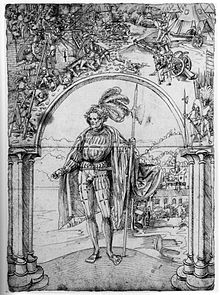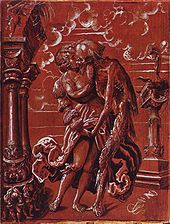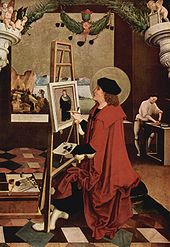Niklaus Manuel
Niklaus Manuel , called German , (* probably 1484 in Bern ; † April 28, 1530 in Bern), was a poet , painter , graphic artist , woodcut master, reformer and Bernese statesman .
Life

Confirmed data about the life of Niklaus Manuel are only available from 1509, and the year of birth is only mentioned in later credible documents. Presumably, he is the son of a pharmacist based in Bern Emanuel de Alemanis (also Allemanis) and Margaretha Fricker (also Frikart), an extramarital daughter of Brugg originating Thüring Fricker , town clerk in Bern. He is considered to be the progenitor of the Manuel patrician family .
Nothing is known about his youth and education. In 1509 he married Katharina Frisching , the daughter of Hans Frisching (I.) , a former bailiff of Erlach , Aarburg , Echallens and Nidau and a member of the small council. On the occasion of the wedding, he dropped the name Aleman (also Alleman), which had been used until then, and was now called Niklaus Manuel. Since then, Manuel’s signature and seal have had the initials NMD , which were initially separated and later written in ligaments and connected by a dagger. It is generally assumed that the letter "D" stands for the Germanized version of the name Aleman. Six children resulted from the marriage with Katharina:
- Margaretha, (* 1516)
- Hieronymus, (* 1520; † 1579)
- Magdalena, (* 1524)
- Hans Rudolf, (* 1525; † 1571), painter, draftsman, wood carver and poet
- Johannes, (* 1527)
- Niklaus Manuel Deutsch d. J., (* 1528; † 1588), glass painter
Before 1511, Niklaus Manuel became a member of the Grand Council in Bern. In 1512 he was accepted into the Ober-Gerwern Society . In 1513 he was officially listed as a painter for the first time in the bills of the city of Bern and there is evidence that he received several commissions. In the following year he acquired the house at Gerechtigkeitsgasse 72, which remained in the family until the 17th century.
In 1516 he hired himself as a traveler and took part in the Milan campaign as secretary to the mercenary leader Albrecht vom Stein in French service . Between 1516/17 he began to paint his famous dance of death on the wall of the Dominican monastery in Bern. With his workshop he painted the choir vault of the Bern Minster with the 86 keystones before 1517. Numerous other works followed. In 1518 he created the woodcut series The clever and the foolish virgin . The last signed paintings were made around 1520.
In the following years he devoted himself increasingly to his literary work. In 1520 he became Venner zu Gerwern and thus held another important office in his hometown.
He successfully stood up for the implementation of the Reformation in Bern. His drastic anti-Catholic carnival games met with a strong response from the population and are said to have done more for the cause of the Reformation in Bern than the sermons of Berchtold Haller . His dance of death , which was not exactly flattering to the clergy, had a similar effect . Niklaus Manuel was one of the leading people of the Reformation in Bern and traveled to numerous Swiss cities on this mission.
In 1522 Niklaus Manuel hired himself out again as field clerk with Albrecht von Stein and took part in another campaign to Lombardy . At Novara he was wounded in the hand. Later he also took part in the Battle of Bicocca . In 1523 he became governor of Erlach , Echallens and Nidau . In 1526 he was briefly a deputy to the federal assembly in Baden . From April 1528 he was listed for the first time as a member of the Small Council of Bern. He held this office until his death.
Artistic work
In his drama, Manuel combined the Christian spiritual game with elements of the carnival game to create realistic, politically current pieces of artistic importance. He illustrated some of his works himself. J. Bächtold obtained a complete edition of his dramas in 1878.
As a painter and woodcut artist, he was influenced by the Italian Renaissance and Albrecht Dürer . Alongside Holbein , he was the most important representative of Renaissance painting on Swiss soil. He created designs for goldsmithing , altarpieces , portraits and other paintings. His colorful and linearly moving pictures mostly depicted mythological or biblical scenes; as a glass painter he was under the influence of Hans Baldung . The most famous of his works was the Bernese Dance of Death from 1516/17 to 1519/20 on the southern, more than 100-meter-long churchyard wall of the Bern Dominican monastery , which was destroyed in 1660 when the wall was demolished.
After the minster builder Peter Pfister had moved in the new net vault in the choir of the Bern minster in 1515/17 , Manuel and his journeymen painted the gussets with ornaments. The Mauresque painting of the vault caps was applied freehand without preliminary drawings or templates. During the most recent restoration from 2015 to 2017, the subsurface and the original colors were cleaned and secured.
A parapet statue of Niklaus Manuel stands on the facade of the main building of the Berner Kantonalbank , and a memorial plaque has been attached to his home at Gerechtigkeitsgasse 72.
Works of art
Selected paintings
-
Basel, public art collection
- Pyramus and Thisbe. around 1513/14
- Saint Anna Selbdritt with Saints James and Rochus as intercessors for humanity plagued by the plague. around 1514/15
- The beheading of St. John the Baptist. around 1517
- Board painted on both sides. 1517
- Front: Death as a Landsknecht hugs a girl.
- Back: Bathsheba bathing.
- Lucretia. 1517
- The judgment of Paris. around 1517/18
-
Bern, art museum
- Two wings of an altar of St. Anne. 1515
- Left wing (outside): St. Eligius in his workshop.
- Left wing (inside - separated): The encounter at the Golden Gate.
- Right wing (outside): St. Luke paints the Madonna.
- Right wing (inside): The Nativity of Mary.
- Portrait of a Man. around 1515
- Martyrdom of St. Ursula. around 1515/16
- The beheading of St. John the Baptist. around 1515/16
- Two wings of an altar of St. Catherine. around 1516
- Both wings (outside): The torture of ten thousand Christians.
- Left wing (inside): Saint Achatius.
- Right wing (inside): Saint Barbara.
- The conversion of Saul. around 1516/17
- Board painted on both sides. around 1516 - 1520
- Obverse: The Adoration of the Magi.
- Back: The sending out of the apostles. (only preserved in fragments)
- Two wings of an altar of St. Anthony the Hermit. 1520
- Left wing (outside): The temptation of St. Anthony by a woman.
- Left wing (inside - separated): Saint Anthony heals the sick and the possessed.
- Right wing (outside): The temptation of St. Anthony by the demons.
- Right wing (inside): The holy hermits Antonius and Paul in the desert.
- Portrait of a Knight from the Holy Sepulcher. 1520
- Self-portrait. 1520
- Two wings of an altar of St. Anne. 1515
-
Winterthur, Oskar Reinhart Collection
- Wing of a Marian altar. 1515
- Left wing (outside): St. Eligius as a goldsmith.
- Left wing (inside): The encounter at the Golden Gate.
- Wing of a Marian altar. 1515
Selected drawings
-
Basel, public art collection
- Tear pane with the coat of arms of Hattstadt held by a woman in front of a landscape with a castle, as well as fighting wild men and their children caring for wild women. around 1508 - 1512
- The temptation of Saint Anthony.
-
Berlin, Kupferstichkabinett
- Rock island. around 1510 - 1515
- Standing witch. around 1518
-
Dessau, Anhaltische Gemäldegalerie
- Portrait of a Young Woman. around 1528 - 1530
- Portrait of a Young Man. around 1528 - 1530
-
Los Angeles, J. Paul Getty Museum
- The Mocking of Christ. around 1513/14
-
New York, Frick Collection
- Landsknecht with flag and woman on horseback. around 1522
-
Paris, Musee National du Louvre
- Allegory of Death.
Literary work
- On the Pope and Christ's Opposition , 1522 (drama)
- A pretty new song and responsibility of the storm half-blown at Pigogga , 1524
- On the Pope and His Priesthood , 1524 (play)
- The indulgent dealer , 1525 (play)
- Barbali , 1526
- Fabers and Eggen Badenfahrt , 1526 (poems)
- Illness and Testament of Mass , 1528 (satire)
- A new pretty game by Elsli Tragdenknaben , 1529
Trivia
Manuelstrasse in Bern has been named after Niklaus Manuel since 1900.
literature
- Jakob Baechtold : Manuel, Niklaus . In: Allgemeine Deutsche Biographie (ADB). Volume 20, Duncker & Humblot, Leipzig 1884, pp. 275-280.
- Michael Egli, Hans Christoph von Tavel: Niklaus Manuel. Catalog raisonné . With contributions by Petra Barton Sigrist. Ed .: Swiss Institute for Art Research , Burgerbibliothek Bern. Schwabe, Basel 2017 (= oeuvre catalogs of Swiss artists; 29; writings of the Burgerbibliothek Bern ), ISBN 978-3-7965-3630-4 .
- Glenn Ehrstine: Theater, Culture, and Community in Reformation Bern, 1523–1555 (= Studies in Medieval and Reformation Thought, 85). Brill, Leiden 2002 ISBN 90-04-12353-9 .
- Lucas Marco Gisi: Niklaus Manuel and the Bernese iconoclasm. In: Peter Blickle , André Holenstein, Heinrich Richard Schmidt, Franz-Josef Sladeczek (eds.): Power and powerlessness of images. Reformation iconoclasm in the context of European history (= historical magazine . Supplements 33). Oldenbourg, Munich 2002, ISBN 3-486-64433-5 , pp. 143-163.
- Hans-Jürgen Greif : The verdict. The painter Niklaus Manuel Deutsch in the turmoil of the Reformation. Novel. (Le jugement) Stämpfli, Bern 2011. (French version translated by the author)
- Hans Rudolf Lavater: Niklaus Manuel Deutsch - Topics and tendencies. In: 450 Years of the Bern Reformation (= archive of the Historical Association of the Canton of Bern 64/65). Stämpfli, Bern 1981, pp. 60-103.
- Urs B. Leu: Manuel, Niklaus. In: Biographisch-Bibliographisches Kirchenlexikon (BBKL). Volume 5, Bautz, Herzberg 1993, ISBN 3-88309-043-3 , Sp. 731-737.
- Caesar Menz, Hugo Wagner (Red.): Niklaus Manuel Deutsch. Painter, poet, statesman. Kunstmuseum Bern, Bern 1979.
- Mats Staub: Niklaus Manuel . In: Andreas Kotte (Ed.): Theater Lexikon der Schweiz . Volume 2, Chronos, Zurich 2005, ISBN 3-0340-0715-9 , p. 1172.
- Jean-Paul Tardent: Niklaus Manuel as statesman (= archive of the Historical Association of the Canton of Bern 51, ISSN 0250-5673 ). Stämpfli, Bern 1967 (also: Bern, Phil.-hist. F., Diss.).
- Hans Christoph von Tavel: Manuel, Niklaus. In: New German Biography (NDB). Volume 16, Duncker & Humblot, Berlin 1990, ISBN 3-428-00197-4 , pp. 95-97 ( digitized version ).
- Hugo Wagner: The former high altar of the Predigerkirche in Bern by Niklaus Manuel. To its reconstruction. In: Journal for Swiss Archeology and Art History, Vol. 34 (1977), pp. 280–293. doi : 10.5169 / seals-166759
- Berchtold Weber: Streets and their names. Using the example of the city of Bern. Bern 1990.
Web links
- Literature by and about Niklaus Manuel in the catalog of the German National Library
- Works by Niklaus Manuel at Zeno.org .
- Works by Niklaus Manuel in the Gutenberg-DE project
- Niklaus Manuel in the Internet Archive
- Michael Egli and Hans Christoph von Tavel: Niklaus Manuel. Catalog raisonné , with contributions by Petra Barton Sigrist, Basel 2017: * Online publication
- Hans Christoph von Tavel: Manuel, Niklaus. In: Historical Lexicon of Switzerland .
- Hans Christoph von Tavel: Manuel, Niklaus. In: Sikart
Individual evidence
- ^ Stefan Gasser: The vault capstones of the Bern Minster Choir, in: The Bern Minster, 500 years of choir vaults; Art and Architecture in Switzerland, vol. 68 No. 2, 2017, pp. 16–24.
- ↑ Urs Martin Zahnd : The Bernese society in the mirror of Niklaus Manuels Totentanz "... aller Wallen Figur ..." ( page no longer available , search in web archives ) Info: The link was automatically marked as defective. Please check the link according to the instructions and then remove this notice. UNIPRESS - Issue 100, April 1999. Accessed: November 24, 2009
- ↑ Münster construction management Bern: Brief information on the status of restoration work in the choir for the Association of Friends of the Bern Minster, December 2015
- ↑ Hartmut Boockmann: The city in the late Middle Ages Munich 1994, p. 282 ISBN 3-406-31565-8
- ↑ Weber 1990, p. 198.
| personal data | |
|---|---|
| SURNAME | Manuel, Niklaus |
| ALTERNATIVE NAMES | Manuel Deutsch, Niklaus |
| BRIEF DESCRIPTION | Bernese playwright, painter, graphic artist and statesman |
| DATE OF BIRTH | around 1484 |
| PLACE OF BIRTH | Bern |
| DATE OF DEATH | April 28, 1530 |
| Place of death | Bern |






